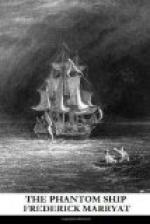“We are unfortunate in thus parting with all our consorts,” observed Mynheer Kloots to Philip, as they were standing at the gangway; “but it must be near meridian, and the sun will enable me to discover our latitude. It is difficult to say how far we may have been swept by the gale and the currents to the northward. Boy, bring up my cross-staff, and be mindful that you do not strike it against anything as you come up.”
The cross-staff at that time was the simple instrument used to discover the latitude, which it would give to a nice observer to within five or ten miles. Quadrants and sextants were the invention of a much later period. Indeed, considering that they had so little knowledge of navigation and the variation of the compass, and that their easting and westing could only be computed by dead reckoning, it is wonderful how our ancestors traversed the ocean in the way they did, with comparatively so few accidents.
“We are full three degrees to the northward of the Cape,” observed Mynheer Kloots, after he had computed his latitude. “The currents must be running strong; the wind is going down fast, and we shall have a change, if I mistake not.”
Towards the evening it fell calm, with a heavy swell setting towards the shore; shoals of seals appeared on the surface, following the vessel as she drove before the swell; the fish darted and leaped in every direction, and the ocean around them appeared to be full of life as the sun slowly descended to the horizon.
“What is that noise we hear?” observed Philip; “it sounds like distant thunder.”
“I hear it,” replied Mynheer Kloots. “Aloft there; do you see the land?”
“Yes,” replied the man, after a pause in ascending the topmast shrouds. “It is right ahead—low sand-hills, and the sea breaking high.”
“Then that must be the noise we hear. We sweep in fast with this heavy ground-swell. I wish the breeze would spring up.”
The sun was dipping under the horizon, and the calm still continued: the swell had driven the Ter Schilling so rapidly on the shore that now they could see the breakers, which fell over with the noise of thunder.
“Do you know the coast, pilot?” observed the captain to Schriften, who stood by.
“Know it well,” replied Schriften; “the sea breaks in twelve fathoms at least. In half an hour the good ship will be beaten into toothpicks, without a breeze to help us.” And the little man giggled as if pleased at the idea.
The anxiety of Mynheer Kloots was not to be concealed; his pipe was every moment in and out of his mouth. The crew remained in groups on the forecastle and gangway, listening with dismay to the fearful roaring of the breakers. The sun had sunk down below the horizon, and the gloom of night was gradually adding to the alarm of the crew of the Ter Schilling.
“We must lower down the boats,” said Mynheer Kloots to the first mate, “and try to tow her off. We cannot do much good, I’m afraid; but at all events the boats will be ready for the men to get into before she drives on shore. Get the tow ropes out and lower down the boats, while I go in to acquaint the supercargo.”




